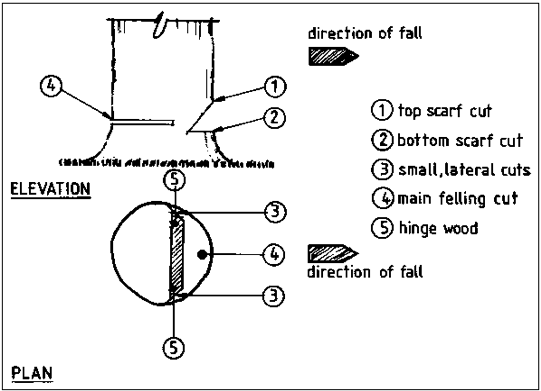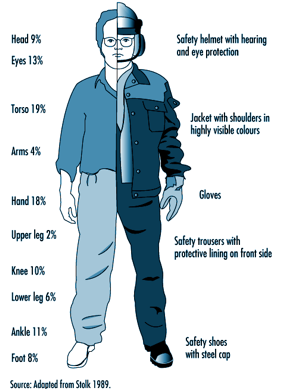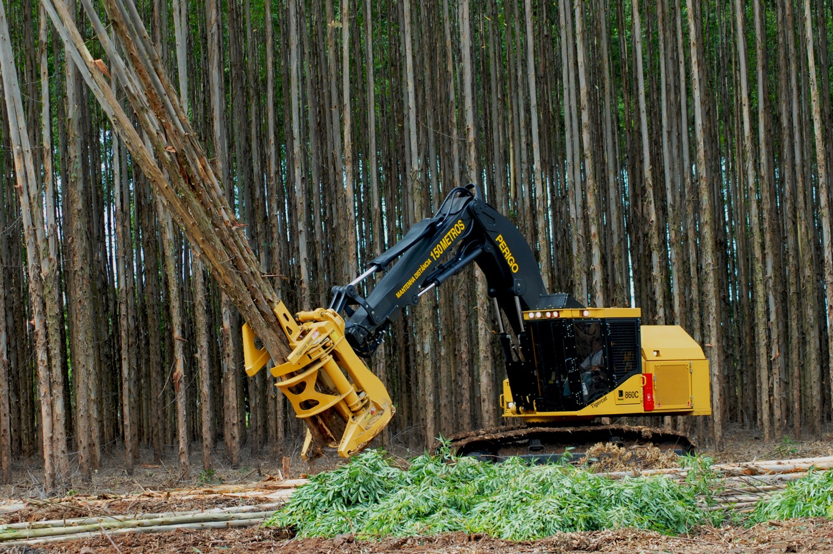Module 8: Harvest and Transport of Forest Products
Topic 8.1: Tree Felling Tools and Techniques
Whether trees are felled by hand with axes or are sheared off and yarded with integrated, self-loading feller-bunchers, felling can be done properly or wastefully. After logging is completed, a great deal can be learned from the care with which it was carried out but “reading” the stumps. Stumps should be low lest wood be wasted. The cuts should be clean, that is, without large splinters remaining from the butt log that was removed. The “barber chair” effect (Figure 8.1.1) represents a great loss of value from the butt log, the split portions of which are then often bucked off and left to rot in the forest. In order to minimize such wastage, fellers should be trained in proper felling techniques. Where coppicing from stumps is an anticipated mode of regeneration, clean cuts close to the ground at a slight angle (to facilitate drainage) are generally preferred. Finally, careless or untrained fellers often break logs by dropping them over boulders or each other. Tree species differ in their susceptibility to such breakage, but laying trees down in a pre-selected direction generally avoids this problem.
By felling trees in pre-selected directions, great reductions in residual stand damage are possible; yarding operations can also be facilitated and the safety of fellers can be increased. Unfortunately, anyone who can swing an axe or wield a chainsaw can cut down a tree (and all too often do); often the only prerequisite for being hired as a feller is having access to a chainsaw.

Figure 8.1.1. Proper felling technique.
Directional felling is applied physics, mixed in with an understanding of wood properties. To accurately and safely direct the fall of a tree requires notching in the proper way and leaving the appropriate “holding” wood. One common mistake is notching too deeply, and thereby leaving too little of the holding wood that is so necessary for swinging the tree away from the direction it would naturally fall due to lean and crown asymmetry. The difference between the arc of potential felling directions of a trained and an experienced but untrained feller might be as much as 45 degrees. Training can greatly enhance fellers’ versatility and increase their personal safety, but logging will nevertheless remain a very dangerous profession.
Given the huge number of trees cut for firewood and charcoal- making in the tropics, undoubtedly more trees are felled with axes than with any other tool. Even in some small-scale commercial timber operations, felling is by axe. Using cross-cut saws wielded by two people reduces the labor somewhat, but the work is still slow and arduous. Rapid tree felling really only became feasible in the 1930s with the advent of chainsaws, which started to become common in tropical logging operations in the 1960s. With chainsaws came new sorts of industrial accidents including, somewhat surprisingly, frequent head-wounds due to “kickback” of the saw. Standard safety gear for chainsaw operators (Figure 8.1.2) should be mandatory on all logging operations as should training. Professionalizing logging operations will help protect workers from injury and protect the forest from avoidable damage.

Figure 8.1.2. Recommended safety gear for tree fellers. The proportions given on the left side of the figure refer to the frequencies of injuries to different parts of the body. One behavioral requirement for safe felling is the opening of two escape routes from the stump.
Various tractor-mounted machines have been developed for felling trees, sometimes integrated with mechanisms to yard logs (Figure 8.1.3). Where timber is small, stocking is dense, and labor costs are high, the purchase price of such sophisticated machinery can be quickly amortized and the substantial maintenance costs can be afforded as well. When the felling head uses shears and not double chainsaw-like devices, care must be taken to assure that the butt log does not suffer value-reducing compression damage.

Figure 8.1.3. A feller buncher used to cut and then stack the boles of small trees.
